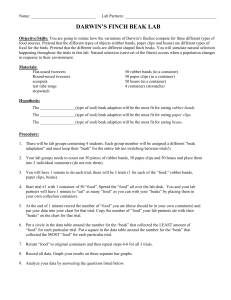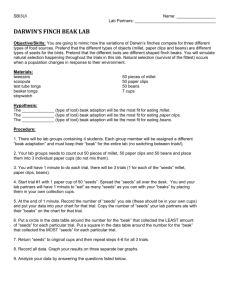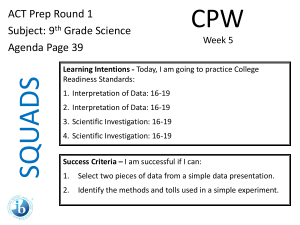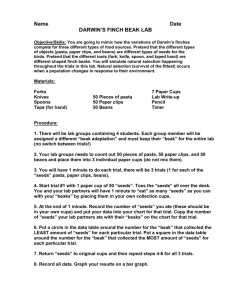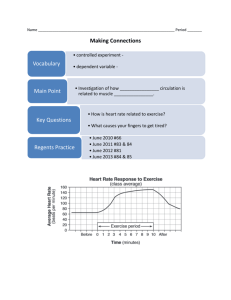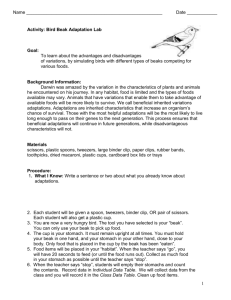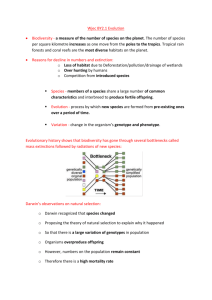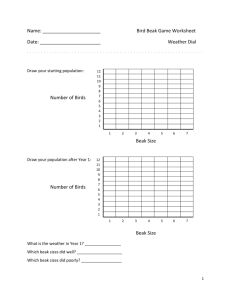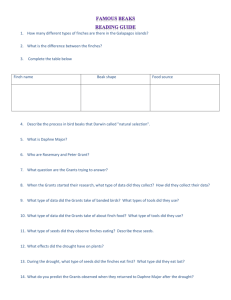darwin`s finch beak lab
advertisement
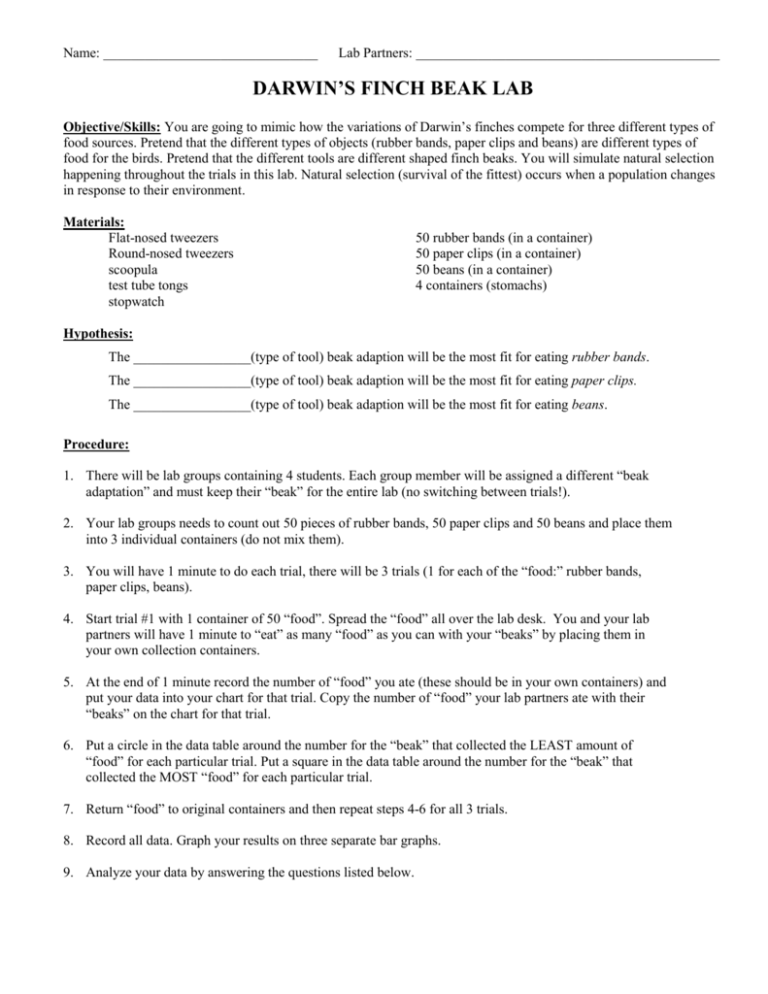
Name: _______________________________ Lab Partners: ____________________________________________ DARWIN’S FINCH BEAK LAB Objective/Skills: You are going to mimic how the variations of Darwin’s finches compete for three different types of food sources. Pretend that the different types of objects (rubber bands, paper clips and beans) are different types of food for the birds. Pretend that the different tools are different shaped finch beaks. You will simulate natural selection happening throughout the trials in this lab. Natural selection (survival of the fittest) occurs when a population changes in response to their environment. Materials: Flat-nosed tweezers Round-nosed tweezers scoopula test tube tongs stopwatch 50 rubber bands (in a container) 50 paper clips (in a container) 50 beans (in a container) 4 containers (stomachs) Hypothesis: The _________________(type of tool) beak adaption will be the most fit for eating rubber bands. The _________________(type of tool) beak adaption will be the most fit for eating paper clips. The _________________(type of tool) beak adaption will be the most fit for eating beans. Procedure: 1. There will be lab groups containing 4 students. Each group member will be assigned a different “beak adaptation” and must keep their “beak” for the entire lab (no switching between trials!). 2. Your lab groups needs to count out 50 pieces of rubber bands, 50 paper clips and 50 beans and place them into 3 individual containers (do not mix them). 3. You will have 1 minute to do each trial, there will be 3 trials (1 for each of the “food:” rubber bands, paper clips, beans). 4. Start trial #1 with 1 container of 50 “food”. Spread the “food” all over the lab desk. You and your lab partners will have 1 minute to “eat” as many “food” as you can with your “beaks” by placing them in your own collection containers. 5. At the end of 1 minute record the number of “food” you ate (these should be in your own containers) and put your data into your chart for that trial. Copy the number of “food” your lab partners ate with their “beaks” on the chart for that trial. 6. Put a circle in the data table around the number for the “beak” that collected the LEAST amount of “food” for each particular trial. Put a square in the data table around the number for the “beak” that collected the MOST “food” for each particular trial. 7. Return “food” to original containers and then repeat steps 4-6 for all 3 trials. 8. Record all data. Graph your results on three separate bar graphs. 9. Analyze your data by answering the questions listed below. Data Collection & Graph (20 points based on MYP Rubric Criterion C): Circle the LOWEST performing “beak” for each trial (this represents extinction). Put a box around the HIGHEST performing “beak” for each trial. Rubber bands Number of Rubber bands Food Eaten With Each Beak Type Trial Number Trial 1 Trial 2 Trial 3 Average Flat-Nosed Tweezers Scoopula Round-Nosed Tweezers Test Tube Tongs Beans Number of Beans Eaten With Each Beak Type Trial Number Trial 1 Trial 2 Trial 3 Average Flat-Nosed Tweezers Scoopula Round-Nosed Tweezers Test Tube Tongs Paper Clips Number of Paper Clips Eaten With Each Beak Type Trial Number Trial 1 Trial 2 Trial 3 Average Flat-Nosed Tweezers Scoopula Round-Nosed Tweezers Test Tube Tongs Graphs: Using the attached graph paper, create three separate bar graph clusters to show the average score for each food type. Be sure to put the independent variable on the x-axis. Use a legend and colors to graph all four beak adaptations for each trial cluster. Analysis: Refer to your charts and bar graphs to answer the following questions. 1. Which finch became extinct in the rubber bands trials? _____________________________ 2. Why did this finch become extinct? ______________________________________________ 3. Which finch was best fit for survival on this “food” type? _____________________________ 4. Why was this finch best fit for survival? __________________________________________ ___________________________________________________________________________ 5. Which finch became extinct in the paper clip trials?_________________________________ 6. Why did this finch become extinct?_______________________________________________ 7. Which finch was best fit for survival on this “food” type? _____________________________ 8. Why was this finch best fit for survival? __________________________________________ ___________________________________________________________________________ 9. Which finch became extinct in bean trials?________________________________ 10. Why did this finch become extinct?________________________________________ 11. Which finch was best fit for survival on this “food” type? _____________________________ 12. Why was this finch best fit for survival? __________________________________________ ___________________________________________________________________________ By analyzing all of the trials’ collected data: 13. Which finch “beak” performed best over all the trials?________________________________ 14. Did this answer match your hypothesis? __________________ 15. Why did this finch “beak” perform best? ____________________________________________ ______________________________________________________________________________ 16. Which finch “beak” performed worst over all the trials?______________________________ 17. Did this answer match your hypothesis? __________________ 18. Why did this finch “beak” perform worst? _________________________________________ ___________________________________________________________________________ Conclusion (20 points based on MYP Rubric Criterion A): Explain and discuss evolution by natural selection, including how this lab experience and your DATA modeled it. YOU MUST REFERENCE DATA FROM YOUR ANALYSIS! During the write-up, you must use EACH of the following terms: population, environment, competition, fitness, variation, adaptation, and extinction. _________________________________________________________________________________ _________________________________________________________________________________ _________________________________________________________________________________ _________________________________________________________________________________ _________________________________________________________________________________ _________________________________________________________________________________ _________________________________________________________________________________ _________________________________________________________________________________ _________________________________________________________________________________ _________________________________________________________________________________ _________________________________________________________________________________ _________________________________________________________________________________ _________________________________________________________________________________ _________________________________________________________________________________ _________________________________________________________________________________ _________________________________________________________________________________ _________________________________________________________________________________ _________________________________________________________________________________ _________________________________________________________________________________ _________________________________________________________________________________ _________________________________________________________________________________ _________________________________________________________________________________ _________________________________________________________________________________ _________________________________________________________________________________ _________________________________________________________________________________ _________________________________________________________________________________ _________________________________________________________________________________ _________________________________________________________________________________ _________________________________________________________________________________ _________________________________________________________________________________ _________________________________________________________________________________ _________________________________________________________________________________ _________________________________________________________________________________ _________________________________________________________________________________ _________________________________________________________________________________ _________________________________________________________________________________ _________________________________________________________________________________ Graphs: Create three separate bar graph clusters to show the average score for each food type. Put the independent variable on the x-axis. Use a legend and colors to graph all four beak adaptations. Rubber-Bands Beans Paper Clips MYP Criterion Score Lab Grade Conversion MYP Score 8 7 6 5 4 3 2 1 Traditional Score 20pts 19pts 17pts 16pts 14pts 12pts 10pts 8pts Each section is worth 20pts for a 40pt total Data & Graphs: Criterion C Conclusion Essay: Criterion A Criterion C: Processing and evaluating Maximum: 8 At the end of year 5, students should be able to: i. present collected and transformed data Achievement level 0 1–2 Level descriptor Task-Specific Language The student does not reach a standard identified by any of the descriptors below. The student is able to: collect and present data in numerical and/or visual forms … Data table is complete, but no graphical representation. 3–4 The student is able to: correctly collect and present data in numerical and/or visual forms Data sloppy. Either erroneous or not readable. Graphs not done well/reflective of data, do not have titles/axes labeled, etc. 5–6 The student is able to: correctly collect, organize and present data in numerical and/or visual forms Data averaged incorrectly or reflect collecting bias/error, but graphs done at a 7-8 level. 7–8 The student is able to: correctly collect, organize, transform and present data in numerical and/or visual forms Your data tables are complete, clearly written and averages are correct (data transformation). The 3 sets of bar graphs are clearly titled, axes labeled, and keys easily distinguish between types of beaks. Criterion A: Knowing and understanding Maximum: 8 At the end of year 5, students should be able to: i. explain scientific knowledge ii. apply scientific knowledge and understanding to solve problems set in familiar and unfamiliar situations iii. analyse and evaluate information to make scientifically supported judgments. Achievement level 0 1–2 3–4 5–6 7–8 Task-Specific Language Level descriptor The student does not reach a standard identified by any of the descriptors below. … The student is able to: state scientific knowledge interpret information to make judgments. 1-2 means you defined each word independently. You cited data, but didn’t talk about how it supported what you are concluding and explaining. The student is able to: outline scientific knowledge interpret information to make scientifically supported judgments. 3-4 means that you defined each vocab in a sensible order, but did not interconnect it. You do not make explicit connections with your data to support your conclusion. The student is able to: describe scientific knowledge analyse information to make scientifically supported judgments. The student is able to: explain scientific knowledge analyse and evaluate information to make scientifically supported judgments. 5-6 means you just describe the different vocab, not weaving them together to construct an explanation of what occurred. You used each vocab. word to explain how natural selection was applied and modeled in this lab. You analyse and use your DATA (from the lab) to support your explanation, including an EVALUATION of how well the data was collected.

